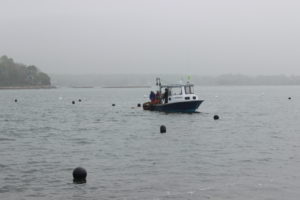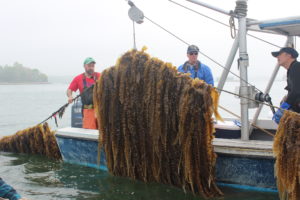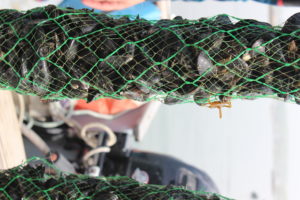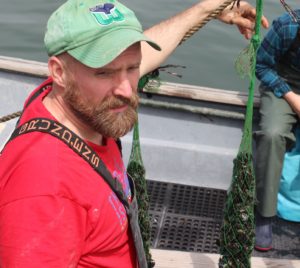Developing a community of ocean farmers for healthy seas, healthy food, and healthy economies
Small-scale ocean farming is restorative and provides valuable ecosystem services through nutrient extraction and carbon sequestration. There are opportunities to put skilled, entrepreneurial people to work for a more sustainable, less exploiting use of the sea.
I boarded the skiff with my camera strapped to my neck to keep it from plunging into the depths of Long Island Sound. My guide gunned the engine and we followed the converted lobster boat as it cut wakes in the glassy water, past an anchorage of mooring buoys where an awkward combination of pleasure boats and workboats awaited their owners in the stillness of the morning. I sat on a flotation in the bow of the skiff and watched the boat from a distance, admiring the gentle curve of its gunwale.

An ocean farm has a light visual footprint; all the crops are under the surface. Lee Rinehart / NCAT
We followed the boat past small rocky islands, some capped with extravagant houses, where terns, plovers, and sandpipers forage and tend their clutches. Composed mostly of yellowing brown rock, some of the islands had rugged, windblown trees gripping the rocks as if to hold on for dear life in the face of a desperate nor’easter … which they undoubtedly have many times in their history. Once the islands were behind us, a broad, vast expanse of the sound stretched beyond the bow, with misty shorelines to the left and right a few miles off in the distance. Off the starboard bow my guide pointed to our destination. Scattered upon the surface of the gray water were numerous round buoys, some black, some white, with several white and orange navigation buoys standing sentinel over their peers. We’d arrived at an ocean farm. Specifically, one leased by Bren Smith, a Branford, CT, farmer who raises kelp and blue mussels beneath the buoys on this 20-acre plot
The pilot shut off the engine and drifted toward the buoys, and I began snapping pictures. When we approached a black buoy, looking like a large bowling ball floating on the surface, a crew member leaned over the gunwale and plunged a boat hook beneath the surface, then pulled it toward the boat as a rope longline broke the surface … the very substrate and structure that forms the backbone of the ocean farm. The longline, covered with leathery seaweed, was grappled with a hooked line that was fed up to a boom block and down to a winch, which allowed the crew to lift the longline, heavy with kelp, effortlessly out of the water.

Kelp harvest in Long Island Sound. Lee Rinehart / NCAT
Sugar kelp hung from the line like a brown, dense, maritime curtain, perhaps 10 feet in length from the longline to where the tips disappeared into the water. After longline was secured, the crew began to cut fronds from the hanging kelp and place them into plastic-bag-lined fish totes on the deck of the boat, with food grade pieces in one tote and fertilizer grade in the other. Once harvest was complete, the bags were tied and placed in the shade, and the boat began its 15-minute trip back to the pier, where the kelp would be cooled and made ready for delivery to its destination as fresh sea produce.
This kelp crop used no fertilizer during its seven-month winter growing season. No pesticides were sprayed. It needed no tillage, weed control, nor fallow. All it required was a sturdy infrastructure to grow on and an appropriate site in the bay where enough tidal flow and current would bring nutrients to its macro-algal fronds. And for this, it gave a lot in return. It soaked up hundreds of pounds of nitrogen and phosphorus from the bay waters. It provided habitat for juvenile pelagic fish and other sea life. And it served as a companion crop to the 10-foot lines of blue mussels growing alongside.
This is the future of coastal ocean aquaculture and its gaining traction in states from Maine to Connecticut and from Washington to Alaska. It’s a “leave-no-trace” aquaculture that is regenerative and requires no inputs other than hard work, intelligent thought, savvy marketing, and a low-to-moderate capital investment.
The prospect of building a new, restorative food system

Blue mussels growing in a mussel sock. Lee Rinehart / NCAT
Paul Greenberg, in Four Fish: The Future of the Last Wild Food (Penguin Books, 2011) tells a story of how locally sourced seafood markets were once an integral part of US coastal communities. But industrialization and consolidation of production compromised the ecological integrity of their estuaries — which in most seacoast communities were paved over, rip-rapped, and walled. Pollution from industry was the final ingredient, and natural stocks of important coastal species like oysters plummeted.
The problems are not confined to the coast. Of all the diversity of species that once characterized the American diet, few now find their way to the dinner plate. Over-exploitation of the ocean and manipulation of relatively few species as not only skewed the ecology of the fishery, but has resulted in a collective amnesia regarding the natural bounty, diversity, and nutritional quality of the foods that we historically harvested from the sea. We have, in the words of author Paul Greenberg, “ignored the fundamental limits the laws of nature place on ecosystems and have consistently removed more fish than can be replaced by natural processes.”
To regenerate and sustain our coastal waters, we need a new paradigm … new way of thinking and acting that runs counter to the “capital, chemistry, and machines” model of industrial agriculture (a maxim I have borrowed from Chef Dan Barber). We need a place-based ecological model of restorative seafood production that can regenerate our waters while providing opportunities to reclaim the waterfront for sustainable use.
Opportunities abound in putting maritime trade skill to work for a more restorative use of the sea. The fisherman’s knowledge, acquired by a life of navigating vessels and maintaining equipment, can be repurposed to give young people the opportunity to enter into a new trade. Generational experience can be passed on to entrepreneurial people who look to the sea for their physical and cultural sustenance. Retooling this industry, with just a few adjustments of gear and some marketing know-how, can turn the fishery into a viable, regenerative food production system that provides work, financial return, and purpose to coastal communities.

Bren Smith, ocean farmer and founder of GreenWave. Lee Rinehart / NCAT
Ecological aquaculture has taken on many forms, from bottom culture of oysters and quahogs to kelp, mussel, and scallop production on submerged longlines. GreenWave, a non-profit organization developed to assist farmers in entering the business, has designed a system of shellfish and seaweed production that encompasses the entire water column of a near-shore farm, providing sustainable, high quality seafood, fuel, and fertilizer for coastal communities. These farms, from perhaps one to 20 acres in size, provide tons of seafood each season. Market outlets can range from wholesale to Community Supported Fisheries to restaurants, and local farms can have access to nutrient-dense, renewable, fertilizers in the form of kelp-based soil amendments.
Farming in this manner is regenerative, in that no inputs are required … no feed or fertilizer at any point of the production cycle. The marine farms become zones of ecological diversity, drawing hundreds of ocean species and providing habitat for young marine organisms, increasing the ability of estuarial habitat to support life. Ocean farms also provide ecosystem services through nutrient extraction and carbon sequestration. In fact, farmed shellfish and kelp extract an enormous amount of nitrogen, phosphorus, and carbon from the water and can act as a storm-surge protector during extreme weather events, mitigating and softening the effects of tidal inundation.
Regenerative ocean farming is sustainable and provides an opportunity for coastal communities to re-assess their relationships with the sea. Coupled with the sustainable management of wild-capture fisheries, it allows innovative and resourceful people to engage in skilled, meaningful, and remunerative work.
In the next issue, read about how innovative ocean farming entrepreneurs are transforming the food system and regenerating coastal waters while serving as models for others to begin their own ocean farming business.
Interested in finding out more about ocean farming? Contact the author at lee@ncat.org for information on what it takes to get started. You can also listen to Bren Smith’s story at https://www.youtube.com/watch?v=j8ViaskDSeI.
Part of this article has been adapted from the forthcoming ATTRA publication Coastal Ocean Aquaculture: Regenerative farming of seaweed and shellfish for food, fuel, and ecosystem services, by Lee Rinehart. This new guide discusses the current status and future of ocean aquaculture, and covers some basic elements of starting an ocean farm, including seaweed and shellfish production, site selection and gear, permitting, food safety, and marketing.
The ATTRA Sustainable Agriculture Program has served as the premier source of information about sustainable agriculture for U.S. farmers and other agriculturists for more than thirty years. Visit the ATTRA website at https://attra.ncat.org/ for practical publications, podcasts, and tutorials on all aspects of sustainable and regenerative agriculture. You can also speak to an ATTRA Agriculture Specialist to discuss any of your farming questions by calling the ATTRA hotline at 800-346-9140.

